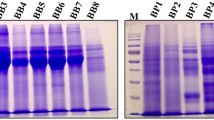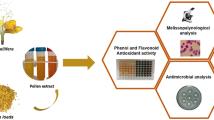Abstract
Bee bread (BB) and bee pollen (BP) are accepted as functional food and considered in medical properties due to its important bioactive components. These bee products show different biological properties, but researches on these aspects have not been clear yet. In present study, Anatolian BB and BP extracts were analyzed for the first time for their pollen type, total phenolic (TPC) and flavonoid content (TFC), and antimicrobial and antioxidant properties. Samples were analyzed for their antimicrobial efficacy by the agar well diffusion and MIC methods. HPLC analysis was used to identify the compounds in the BB and BP samples. Antioxidant activity was measured by the FRAP and DPPH methods. As a result of microscopy for pollen identification, Fagaceae family was dominant. Phenolic compound analysis showed that the amounts of p-coumaric acid and rutin were found to be the highest in BB and BP, respectively. Stronger antioxidant activity was obtained from BP. MIC values of BB were range from 250 to 12.5 μg/mL. The most susceptible bacterium was Mycobacterium smegmatis. The extract of BP was effective on all gram-negative bacteria with doses range from 250 μg/mL to 500 μg/mL. The lowest MIC value was detected with the concentration of 12.5 μg/mL against M. smegmatis. Anatolian BB and BP could be considered as a functional foods due to antioxidant activity and may be beneficial in the management and treatment of pathogenic bacteria because of high antimicrobial activity.


Similar content being viewed by others
Data availability
Authors can confirm that all relevant data are included in the article files.
References
Sonmez E, Kekecoglu M, Bozdeveci A, AlpayKaraoglu S (2022) Chemical profiling and antimicrobial effect of Anatolian honey bee venom. Toxicon 2013:1–6
Dumitru CD, Neacsu IA, Grumezescu AM, Andronescu E (2022) Bee-derived products: chemical composition and applications in skin tissue engineering. Pharmaceutics 14(4):750
Didaras NA, Kafantaris I, Dimitriou TG, Mitsagga C, Karatasou K, Giavasis I, Stagos D, Amoutzias GD, Hatjina F, Mossialos D (2021) Biological properties of bee bread collected from apiaries located across Greece. Antibiotics 10(5):555
Pełka K, Otłowska O, Worobo RW, Szweda P (2021) Bee bread exhibits higher antimicrobial potential compared to bee pollen. Antibiotics 10(2):125
Bobis O, Marghitas LA, Dezmirean D, Morar O, Bonta V, Chirila F (2010) Quality parameters and nutritional value of different commercial bee products. Bull Unıv Agrıc Scı Vet Med Cluj-Napoca Anım Scı Bıotechnol 67(2)
Estevinho ML, Afonso SE, Feás X (2011) Antifungal effect of lavender honey against Candida albicans, Candida krusei and Cryptococcus neoformans. J Food Sci Technol 48:640–643
Kaškonienė V, Katilevičiūtė A, Kaškonas P, Maruška A (2018) The impact of solid-state fermentation on bee pollen phenolic compounds and radical scavenging capacity. Chem Pap 72(8):2115–2120
Dharampal PS, Carlson C, Currie CR, Steffan SA (2019) Pollen-borne microbes shape bee fitness. Proc Royal Soc B 286(1904):20182894
Steffan SA, Dharampal PS, Danforth BN, Gaines-Day HR, Takizawa Y, Chikaraishi Y (2019) Omnivory in bees: elevated trophic positions among all major bee families. Am Nat 194(3):414–421
Bakour M, Laaroussi H, Ousaaid D, El Ghouizi A, Es-Safi I, Mechchate H, Lyoussi B (2022) Bee bread as a promising source of bioactive molecules and functional properties: an up-to-date review. Antibiotics 11(2):203
Urcan A, Mărghıtaș LA, Dezmırean DS, Bobıș O, Bonta V, Mureșan CI, Mărgăoan R (2017) Chemical composition and biological activities of beebread-review. Bull Univ Agric Sci Vet Med Cluj-Napoca Anim Sci Biotechnol 74(1):6–14
Berene I, Daberte I, Siksan S (2015) Investigation of beebread and development of its dosage forms. Medicinos 21(1):16–22
Morais M, Moreira L, Feás X, Estevinho LM (2011) Honeybee-collected pollen from five Portuguese Natural Parks: palynological origin, phenolic content, antioxidant properties and antimicrobial activity. Food Chem Toxicol 49(5):1096–1101
Kroyer G, Hegedus N (2001) Evaluation of bioactive properties of pollen extracts as functional dietary food supplement. Innov Food Sci Emerg Technol 2(3):171–174
Basim E, Basim H, Özcan M (2006) Antibacterial activities of Turkish pollen and propolis extracts against plant bacterial pathogens. J Food Eng 77(4):992–996
Carpes T, Begnini R, Matias de Alencar S, Masson ML (2007) Study of preparations of bee pollen extracts, antioxidant and antibacterial activity. Ciênc agrotec 31:1818–1825
Abouda Z, Zerdani I, Kalalou I, Faid M, Ahami MT (2011) The antibacterial activity of Moroccan beebread and bee pollen (fresh and dried) against pathogenic bacteria. Res J Microbiol 6:376–384
Kurutas EB (2015) The importance of antioxidants which play the role in cellular response against oxidative/nitrosative stress: current state. Nutr J 15(1):1–22
Tangney CC, Rasmussen HE (2013) Polyphenols, inflammation, and cardiovascular disease. Curr Atheroscler Rep 15(5):1–10
Khalifa SAM, Elashal M, Kieliszek M, Ghazala NE, Farag MA, Saeed A, Xiao J, Zou X, Khatib A, Göransson U, El-Seedi HR (2020) Recent insights into chemical and pharmacological studies of bee bread. Trends Food Sci Technol 97:300–316
Mărgăoan R, Strant M, Varadi A, Topal E, Yücel B, Cornea-Cipcigan M, Campos MG, Vodnar DC (2019) Bee collected pollen and bee bread: bioactive constituents and health benefits. Antioxidants 8(12):568
Bakour M, Fernandes Â, Barros L, Sokovic M, Ferreira ICFR, Lyoussi B (2019) Bee bread as a functional product: chemical composition and bioactive properties. LWT 109:276–282
Kieliszek M, Piwowarek K, Kot AM, Błażejak S, Chlebowska-Śmigiel A, Wolska I (2018) Pollen and bee bread as new health-oriented products: a review. Trends Food Sci Technol 71:170–180
Nagai T, Nagashima T, Myoda T, Inoue R (2004) Preparation and functional properties of extracts from bee bread. Food Nahrung 48(3):226–229
Paradowska K, Zielińska A, Krawiec N (2014) Skład i właściwości antyoksydacyjne barwnych frakcji wyodrębnionych z pszczelego pyłku kwiatowego. Postępy Fitoterapii 4:209–215
Can Z, Yildiz O, Sahin H, Turumtay EA, Silici S, Kolayli S (2015) An investigation of Turkish honeys: their physico-chemical properties, antioxidant capacities and phenolic profiles. Food Chem 180:133–141
Warakomska Z, Maciejewicz W (1992) Microscopic analysis of propolis from Polish regions. Apidologie 23(4):277–283
Gencay O, Sorkun K (2006) Microscopic analysis of propolis samples collected from East Anatolia (Kemaliye-Erzincan). FABAD J Pharm Sci 4(31):192–197
Singleton VL, Rossi JA (1965) Colorimetry of total phenolics with phosphomolybdic-phosphotungstic acid reagents. AJEV 16(3):144–158
Fukumoto LR, Mazza G (2000) Assessing antioxidant and prooxidant activities of phenolic compounds. J Agric Food Chem 48(8):3597–3604
Molyneux P (2004) The use of the stable free radical diphenylpicryl-hydrazyl (DPPH) for estimating antioxidant activity. Songklanakarin J Sci Technol 26(2):211–219
Benzie IF, Strain JJ (1999) Ferric reducing/antioxidant power assay: direct measure of total antioxidant activity of biological fluids and modified version for simultaneous measurement of total antioxidant power and ascorbic acid concentration. Methods Enzymol 299:15–27
Sahin H, Kaltalioglu K, Erisgin Z, Coskun-Cevher S, Kolayli S (2019) Protective effects of aqueous extracts of some honeys against HCl/ethanol-induced gastric ulceration in rats. J Food Biochem 43(12):e13054
Seker ME, Ay E, AktasKaracelik A, Huseyinoglu R, Efe D (2021) First determination of some phenolic compounds and antimicrobial activities of Geranium ibericum subsp jubatum: a plant endemic to Turkey. Turk J Chem 45(1):60–70
Kekecoglu M, Sonmez E, Acar M, Karaoglu SA (2021) Pollen analysis, chemical composition and antibacterial activity of Anatolian chestnut propolis collected from Yıgılca Region. Biol Bull 48(6):721–728
Kekecoglu M, Sonmez E, Dorkac P, Eroglu N (2022) Determination of in vitro antimicrobial activities of different propolis samples from Düzce-Yığılca Region against oral microorganisms. KSU J Agric Nat 25(2):234–242
Tomás A, Falcão SI, Russo-Almeida P, Vilas-Boas M (2017) Potentialities of beebread as a food supplement and source of nutraceuticals: botanical origin, nutritional composition and antioxidant activity. J Apic Res 56(3):219–230
Šımunovıć K, Abramovi H, Lilek N, Angelova M, Podržaj L, SmoleMožina S (2019) Microbiological quality, antioxidative and antimicrobial properties of Slovenian bee pollen. Agrofor 4:82–92
Kacaniova M, Vukovic N, Chlebo R, Haščík P, Rovná K, Cubon J, Dzugan M, Pasternakiewicz A (2012) The antimicrobial activity of honey, bee pollen loads and beeswax from Slovakia. Arch Biol Sci 64(3):927–934
Didaras NA, Karatasou K, Dimitriou TG, Amoutzias GD, Mossialos D (2020) Antimicrobial activity of bee-collected pollen and beebread: state of the art and future perspectives. Antibiotics 9(11):811
Graikou K, Kapeta S, Aligiannis N, Sotiroudis G, Chondrogianni N, Gonos E, Chinou I (2011) Chemical analysis of Greek pollen-antioxidant, antimicrobial and proteasome activation properties. Chem Cent J 5(1):1–9
Erkmen O, Ozcan M (2008) Antibacterial effects of Turkish propolis, pollen and laurel on the spoilage and pathogenic food-related microorganisms. J Med Food 11(3):587–592
Khider M, Elbanna K, Mahmoud A, Owayss AA (2013) Egyptian honeybee pollen as antimicrobial, antioxidant agents, and dietary food supplements. Food Sci Biotechnol 22(5):1–9
Bridi R, Atala E, Pizarro PN, Montenegro G (2019) Honeybee pollen load: phenolic composition and antimicrobial activity and antioxidant capacity. J Nat Prod 82(3):559–565
Betts JW, Sharili AS, Phee LM, Wareham DW (2015) In vitro activity of epigallocatechin gallate and quercetin alone and in combination versus clinical isolates of methicillin-resistant Staphylococcus aureus. J Nat Prod 78(8):2145–2148
Vasquez A, Olofsson TC (2009) The lactic acid bacteria involved in the production of bee pollen and bee bread. J Apic Res 48(3):189–195
Iorizzo M, Lombardi SJ, Ganassi S, Testa B, Ianiro M, Letizia F, Succi M, Tremonte P, Vergalito F, Cozzolino A, Sorrentino E, Coppola R, Petrarca S, Mancini M, De Cristofaro A (2020) Antagonistic Activity against Ascosphaera apis and functional properties of Lactobacillus kunkeei strains. Antibiotics 9(5):262
Iorizzo M, Testa B, Lombardi SJ, Ganassi S, Ianiro M, Letizia F, Succi M, Tremonte P, Vergalito F, Cozzolino A, Sorrentino E, Coppola R, Petrarca S, Mancini M, De Cristofaro A (2020) Antimicrobial activity against Paenibacillus larvae and functional properties of Lactiplantibacillus plantarum strains: potential benefits for honeybee health. Antibiotics 9(8):442
De-Melo AAM, Estevinho MLMF, Sattler JAG, Souza BR, da Silva FA, Barth OM, Almeida-Muradian LB (2016) Effect of processing conditions on characteristics of dehydrated bee-pollen and correlation between quality parameters. LWT-Food Sci Technol 65:808–815
Oltica S, Mărghitaş LA, Dezmirean D (2007) Examination of antioxidant capacity of beebread extracts by different complementary assays. Bulletin USAMV-CN 63:1–4
Pascoal A, Rodrigues S, Teixeira A, Feás X, Estevinho LM (2014) Biological activities of commercial bee pollens: antimicrobial, antimutagenic, antioxidant and anti-inflammatory. Food Chem Toxicol 63:233–239
Carpes S, de Alencar S, Cabral I, Oldoni T, Mourao G, Haminiuk C, da Luz CFP, Masson MML (2013) Polyphenols and palynological origin of bee pollen of Apis mellifera L from Brazil characterization of polyphenols of bee pollen. CYTA J Food 11(2):150–216
Kostić AŽ, Milinčić DD, Gašić UM, Nedić N, Stanojević SP, Tešić ŽL, Pešić MB (2019) Polyphenolic profile and antioxidant properties of bee-collected pollen from sunflower (Helianthus annuus L) plant LWT. Food Sci Technol 112:108244
Author information
Authors and Affiliations
Contributions
Emine Sonmez: experimental study, methodology, writing-reviewing and editing, and visualization. Meral Kekecoglu: providing material, editing, supervision, and validation. Huseyin Sahin: experimental study and editing. Arif Bozdeveci: experimental study. Sengul Alpay Karaoglu: experimental study, providing material, editing, supervision, and validation.
Corresponding author
Ethics declarations
Consent to participate
The authors gave informed consent to their inclusion in this study.
Conflict of interest
The authors declare no competing interests.
Additional information
Publisher's note
Springer Nature remains neutral with regard to jurisdictional claims in published maps and institutional affiliations.
Responsible Editor: Aleksander Westphal Muniz
Rights and permissions
Springer Nature or its licensor (e.g. a society or other partner) holds exclusive rights to this article under a publishing agreement with the author(s) or other rightsholder(s); author self-archiving of the accepted manuscript version of this article is solely governed by the terms of such publishing agreement and applicable law.
About this article
Cite this article
Sonmez, E., Kekecoglu, M., Sahin, H. et al. Comparing the biological properties and chemical profiling of chestnut bee pollen and bee bread collected from Anatolia. Braz J Microbiol 54, 2307–2317 (2023). https://doi.org/10.1007/s42770-023-00980-w
Received:
Accepted:
Published:
Issue Date:
DOI: https://doi.org/10.1007/s42770-023-00980-w




